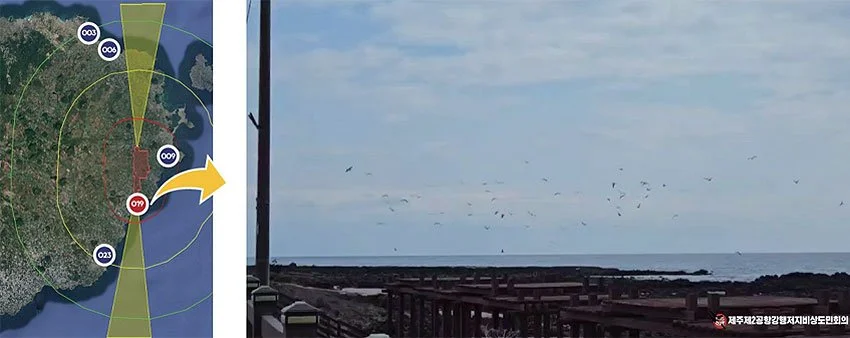"Jeju 2nd Airport, bird strike risk confirmed...fully reviewed"
The Environmental Investigation Committee of the Emergency Citizens' Assembly releases the results of the first bird survey
"MOLIT judges the risk of bird collisions and confirms that countermeasures are inadequate"
"Frequent migration to coastal and inland wetlands... Aircraft parking and access roads are crowded"
Press conference to release the results of the first bird survey by the Jeju Emergency Residents' Association at Jeju Airport 2 on the 29th. ⓒHeadline Jeju
A bird survey in Seongsan-eup, Seogwipo-si, the proposed site of Jeju's second airport, has revealed that the risk of bird strikes during aircraft operations is extremely high. Based on the findings, civil society organizations are calling for a complete review of the second airport plan.
The Environmental Investigation Committee of the Jeju Emergency Residents' Council for Jeju Airport 2 announced the results of the first bird survey at the proposed site of the second airport in Seongsan-eup on the morning of the 29th at the large conference room of the Jeju headquarters of the Democratic Trade Union Confederation.
The survey was organized by the Environmental Investigation Committee of the Emergency Residents' Council and conducted from February 4 to March 16 at 25 locations around the discharge water of land-based aquaculture farms, which are facilities that attract birds.
The survey focused on the population and movement characteristics of birds gathering around the discharge water.
The Emergency Residents' Council pointed out that the Ministry of Land, Infrastructure, and Transport's claim to block bird attraction by moving birds along the coastline, flying below 60 meters, and strengthening filters for land-based aquaculture farm discharge water was very weak.
"The investigation concluded that land-based fish farms are stronger bird attractants than any other facilities, and that unless the 149 fish farms within a 13-kilometer radius are relocated, the second airport will never be safe from bird collisions due to its location," the group said.
Ducks at Songdang Reservoir. Photo by Jeju Jeju 2nd Airport Gangneung Jersey Emergency Residents' Association
"During the day, birds migrate along the coast along the discharge of aquaculture farms, but at night, they show different patterns depending on the type of bird," said the council. "Cormorant family birds migrate first in the direction of the sunrise peak, while gull family birds migrate to flat sandy beaches, Jongdal Coast or Sinsan Coast, where there are flat billets."
"Ducks were the most numerous, and they moved in the direction of inland wetlands after complete darkness," he said. "Even if the birds only move along the coast, there are numerous land-based aquaculture farms along the approach surface of the Sinsan Coast, where aircraft take off and land, and the risk of bird strikes is very high due to the very low flight altitude of aircraft."
"It is estimated that the duck family flies to inland wetlands at night to find a stable resting place to escape from the sky," he said. "Seong-eup Reservoir and Songdang Reservoir, which are located 8 and 10 kilometers away from the second airport, are home to about 1,000 members of the duck family."
"It is false that the birds fly at an average speed of less than 60," he added. "They fly low in normal times, but they fly high when natural enemies such as hawks and cats are expected to attack."
Birds on the shoreline during takeoff and landing of the runway. Photo: Jeju Jeju Airport 2 Emergency Residents Association
Press conference to release the results of the first bird survey by the Jeju Emergency Residents' Association at Jeju Airport 2 on the 29th. ⓒHeadline Jeju
The Residents' Assembly criticized the MOLIT, saying, "It is wrong to interpret the behavioral characteristics of birds in favor of airport construction to the extent of counting the number of birds while passing by in a car."
"In the survey, gulls and other birds of the seagull family were captured flying in groups and flying in circles off the coast of Sinsan, where 80% of aircraft are planned to take off and land."
"MOLIT's claim that the problem of aquaculture farms will be solved by using a dense filter for the discharge water of aquaculture farms is a crude and childish claim that has no dignity as a public institution." "Then, why is it necessary to designate land-based aquaculture farms as bird attracting facilities and restrict them?"
"Birds gather for feeding activities, but the attracting factor is odor," he said, "and since it is impossible to remove the odor, it is designated as a bird attracting facility."
Hong Young-cheol, chairman of the Environmental Survey Committee, explains the results of the first bird survey at Jeju Airport 2 on Monday. ⓒHeadline Jeju
도민회의는 "몇 달이 지나지 않았다. 국토부는 무안공항 참사에 대한 근본적인 반성도 없이 적자공항을 유지한 채 불필요한 신공항 계획을 강행하려 하고 있다"며 "무안공항 참사 이후 공항 정책 변화를 기대했지만, 조류충돌을 1순위 요인으로 결론내면서도, 해결책은 레이더와 드론이 전부였다"고 비판했다.
이어 "무안공항 참사도 레이더에 조류충돌 위험이 감지돼 경고했지만, 충돌을 피하진 못했다"며 "국토부가 일말의 반성이 있었다면, 이런 후안무치한, 있으나 마나한 대토론회를 열지 않았을 것"이라고 성토했다.
또 "이번 조사 결과를 바탕으로 새들을 과별로 나누어 주요 먹이와 서식지, 이동특성을 추가로 조사할 계획"이라며 "이미 성산 지역에서 오랫동안 새들을 관찰해 온 지역주민들과 활동가들의 자료를 기반으로 내륙습지와 해안습지와의 상관관계도 조자할 것"이라고 밝혔다.
이어 "반성없이 제2공항을 비롯한 불필요한 공항들을 만들려는 국토부에 엄중히 경고한다"며 "새들의 서식처를 파괴하고, 사람마저 위험에 빠뜨리는 전국의 신공항 건설 계획을 당장 멈춰야 한다"고 주장했다.
그는 "진정한 성찰에 따른 정책 전환이 없다면, 새 정부에 가장 먼저 국토부를 해체하기 위해 나설 것"이라고 밝혔다. <헤드라인제주>
Press conference to release the results of the first bird survey by the Jeju Emergency Residents' Association at Jeju Airport 2 on the 29th. ⓒHeadline Jeju






